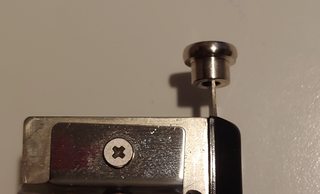I've had an enquiry, whose answer may be of interest here:
Just wanted to let you know that It is a pleasure to follow your posts as you continue to develop your arm.
I know you have given considerable thought to the anti skate mechanism. Can you discuss this? I have never experienced the bent cantilevers you mention, but then I run high compliance cartridges in low - medium mass arms. FWIW, I’ve always set my anti skate by using the 3150 Hz speed check track on a test disk. An artificial signal, but repeatable.
Has the carbon fiber tube made a difference to the effective mass? What do you estimate it to be?
Anti-skate
Here is a description from another forum:
The goal of the anti-skate mechanism is to produce similar anti-skate to other arms. The starting point is different though: most arms are yaw-agnostic - they do not have a favoured track position - whereas, by virtue of its suspension mechanism, Supatrac has a track position which it reverts to without other forces being applied.
This means that at track 5 the arm mostly provides its own anti-skate, without the help of the anti-skate mechanism, whereas at track one the arm has a torque towards the centre in addition to that arising from overhang/offset. Consequently the anti-skate mechanism needs to apply about double anti-skate force at track one, and almost none at the end.
This is why an unusual anti-skate configuration was required. The mechanism gradually reduces anti-skate force from about double the normal amount to almost none as it rotates through the angle of record play. It achieves this using a drawbridge type mechanism so that the standing weight gets pulled almost vertical towards end of side and the thread goes almost slack.
I will see if I have time to make an expository video today.
Effective Mass Reduction by Carbon Fibre
My approach to effective mass has been more experimental than theoretical. I use several Shure M97xE cartridges with stock and JICO styluses, among other cartridges, and these are very high compliance, hence the removable brush stabiliser, which I generally remove altogether. The original aluminium prototypes did work well with these cartridges, but primarily visual cues suggested to me that a lighter arm would suit them better, and in the event subsonic wobbles were obviously less in evidence with the carbon fibre prototype. You could also just feel the additional lightness, stiffness and deadness when handling the arm. I was a little reluctant to admit this since carbon fibre is harder to work with, but the advantage is clear and I have decided to produce no more aluminium arms.
The advantage of a very light arm is that you can easily add effective mass to suit a low compliance cartridge, whereas you can't take it away from a heavy arm for high compliance cartridges. I intend to include with each arm a 4g steel saddle which sits on the arm and can be positioned to taste for users of low compliance cartridges.
The much greater lightness also gave me the leeway to strengthen the arm while keeping effective mass low enough for a Shure M97xE
without damping brush. This has been done with stiffer aluminium inserts around the cartridge mount, stiff foam in one tube, and stiffening inserts at the junction with the thrust-cage. I regard rigidity as a principle!
By nature of the design of the arm it is easy to calculate effective mass very accurately, which I will do as soon as I have some time, but for now I expect it is in the lowish range.
HTH, and thanks for the good questions.


